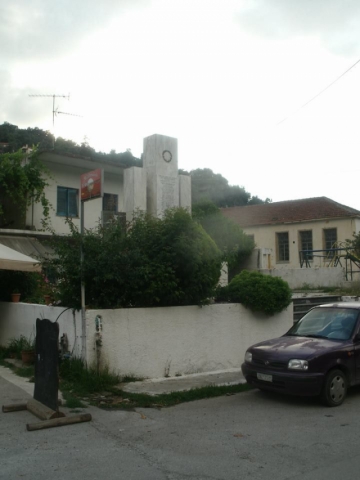Press here.
Places near Church
Hiking and nature close to Zourva village: From Lakki Village - Vrisi gorge and Vrissi water source - Zourva village.
We started from Lakki, a village on the way to Omalos plateau, 460m asl.
The path is marvelous and we enjoyed every step. Our direction was eastward. We were walking discovering gradually all the surprises of this gorge.At the end of the gorge there is a cave with an underground river, from which the gorge took its name (Vrissi=Fount).
Facing the gorge from above we stayed surprised: rugged yet beautiful places, cypresses, oaks and their amazing flowers dominating the view. Unfortunately in the midst of this beauty the signs of the destructive presence of man with the recent fires is obvious.
We are on the way to the cave - fountain and now the path began to be uphill. This old trail becomes more and more difficult.It has been already 3 hours and we approach our destination, the fountain which supplies water the villages Zourva and Lakki, an impressive mountain location with an altidude of 790m.
This gorge (at first the Kidoni gorge from Karanou to north and later on the Mavri gorge to northeast) is covered in green, with huge trees on the banks and leaves everywhere covering the path, which although is engraved, but has to be maintained for many years .
Also the sun is not passed through the dense trees resulting to a pleasant shade, while many small waterfalls made us believe that we were in northern Greece and not in Crete in conjunction with a variety of colors and plants.
This gorge-river is a small paradise for people, but especially for animals and plants, since the ecosystem remains unchanged for many years, without having been affected by any human intervention at all.
In winter till Spring months, in some places the river was relatively brash with some deep passes. However, the river is very clean, with few deep spots, abundant waterfalls, with some scattered garbage on the way mostly plastic, somewhat spoiling the beautiful picture we had.
The end point of the walk can be the village of Fournes.
Lakkoi (Greek: Λάκκοι), commonly spelled Lakki on road signs and maps, is a village on the Greek island of Crete in the foothills of the Lefka Ori (White Mountains). The village is situated on the road between Chania and the plateau of Omalos which leads to the Samaria Gorge.
Lakkoi is 450 meters high, below the White Mountains which rise another 1,000 meters to the south. Most of the houses cling to steep slopes covered in olive and chestnut trees, reached through narrow roads or tracks that run down from the main square.The climate is cool in winter, with occasional snow, wet in spring, hot and dry in the summer. In the unusually dry summer of 2007, major brush fires broke out twice, burning about 2,000 acres and threatening the village itself.Traditionally the villagers have cultivated olives and raised goats, sheep and chickens. With limited work opportunities, the population has declined from a peak of around 2,000 to about 400 today. There are signs of growth as houses are being purchased and renovated by citizens of other European Union countries seeking low-cost retirement or vacation homes.The first historical mention of the village dates from 1263, when the Lakkoi chieftain Pentachtenis took part in a revolt against the Venetians. In a later revolt in 1570 the chieftain George Mousouris became Secretary General of the rebel forces, based in the nearby village of Meskla.After the Ottoman conquest of the island, the people of Lakkoi were involved in periodic revolts, notably the revolt of 1821-1828 during the Greek War of Independence, where an Ottoman army of 5,000 men led by Latif Pasha of Chania was routed in a pitched battle at Lakki. In the great rebellion of 1866-1869 Katerina Stamataki of Lakkoi was a distinguished woman revolutionary.During the Battle of Crete in May 1941 and the days that followed, four hundred and eighty five men and women resisted the German occupiers, and sixty eight Lakkoiotes lost their lives in the fight for the freedom of Greece.
Built among large orange groves, Meskla looks so serene and pretty that it is hard to think it was twice destroyed in the past. But it was. The Venetians, first, and the Turks later, laid everything waste, and it is indeed very fortunate that two Byzantine churches managed to survive, even though they were seriously damaged.
It can be reached by taking the exit to the left in the village of Fournes. The road on the right heads for the villages of Lakki and Omalos. A narrow road with many curves that leads through forest, orange groves and olive groves will take you to Meskla in about 20 to 30 minutes. Meskla is the site of an ancient city, and various artefacts and remains of cyclopean walls have been found here.
The church of Christ the Saviour has some wonderful wall paintings by the hand of the Veneri brothers (1403), but unfortunately they suffered severe and irreparable damage. The church of the Virgin Mary, a little further to the north, is particularly interesting, as it contains parts of earlier buildings including a temple of Aphrodite that was once built in this exact place.
It is also worth noting that the mosaic covering part of the present church floor was once the mosaic floor of a fifth century basilica. Finally, around the village one can see many ancient ruins of homes as well as parts of a city wall. Although it is not certain which city that wall surrounded, the ruins are thought to belong to the ancient town of Rizinia.
The village Askordalos or Skordalou, lies at a distance of 20 km away from the city of Hania at the feet of the White Mountains and 10 km far from Lakkoi village. It is one of the greenest villages in Crete with the oldest olive orchards in Crete and in Europe and the main income of its people comes from olive oil (tsounati variety).
By the end of October 2004, a sudden hot wind storm from Africa caused an electricity pole wire to break. This started a wild fire, which very quickly spread around so much that no one could control it. Twenty-four hours later, the whole region around the village had burnt almost to the ground.
The damage was unprecedented: sixty thousand olive trees over 400 hundred years old had been burnt. The village had been ruined both financially and ecologically.





